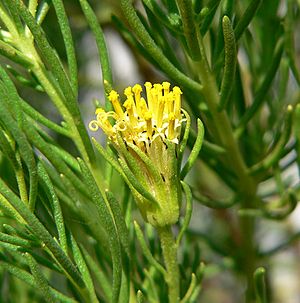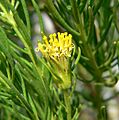Peucephyllum facts for kids
Quick facts for kids Peucephyllum |
|
|---|---|
 |
|
| Conservation status | |
| Scientific classification | |
| Kingdom: | |
| (unranked): | |
| (unranked): | |
| (unranked): | |
| Order: | |
| Family: | |
| Tribe: |
Bahieae
|
| Subtribe: |
Bahiinae
|
| Genus: |
Peucephyllum
|
| Species: |
P. schottii
|
| Binomial name | |
| Peucephyllum schottii |
|
| Synonyms | |
|
Inyonia M.E. Jones |
|
Peucephyllum is a special kind of flowering plant. It is the only species in its group, called a monotypic genus. Its scientific name is Peucephyllum schottii.
People call this plant by many names. Some common names are pygmy cedar, Schott's pygmy cedar, desert fir, and desert pine. Even though it has "cedar," "fir," and "pine" in its name, it is not related to those trees. Instead, it belongs to the aster family, which includes plants like sunflowers and daisies.
This plant is a leafy shrub that stays green all year. Its leaves are a bit sticky because they have special glands that produce resin.
About the Pygmy Cedar
The pygmy cedar has yellow flower heads. These flower heads are made up of only disc florets, which are small, tube-shaped flowers. After the flowers, the plant produces woody seeds. These seeds have a feathery top called a pappus. This feathery part helps the seeds float away in the wind.
Where It Grows
This plant lives in the deserts of North America. You can find it in the United States in Arizona, California, Nevada, and Utah. It also grows in northern Mexico, in Baja California and Sonora.
Looks Like a Creosote Bush
The pygmy cedar looks a lot like another common desert plant, the creosote bush. Both are small and greenish. They often grow in a rounded, bushy shape. Both plants also have similar yellow flowers that bloom in the spring.
Images for kids
See also
 In Spanish: Peucephyllum para niños
In Spanish: Peucephyllum para niños



